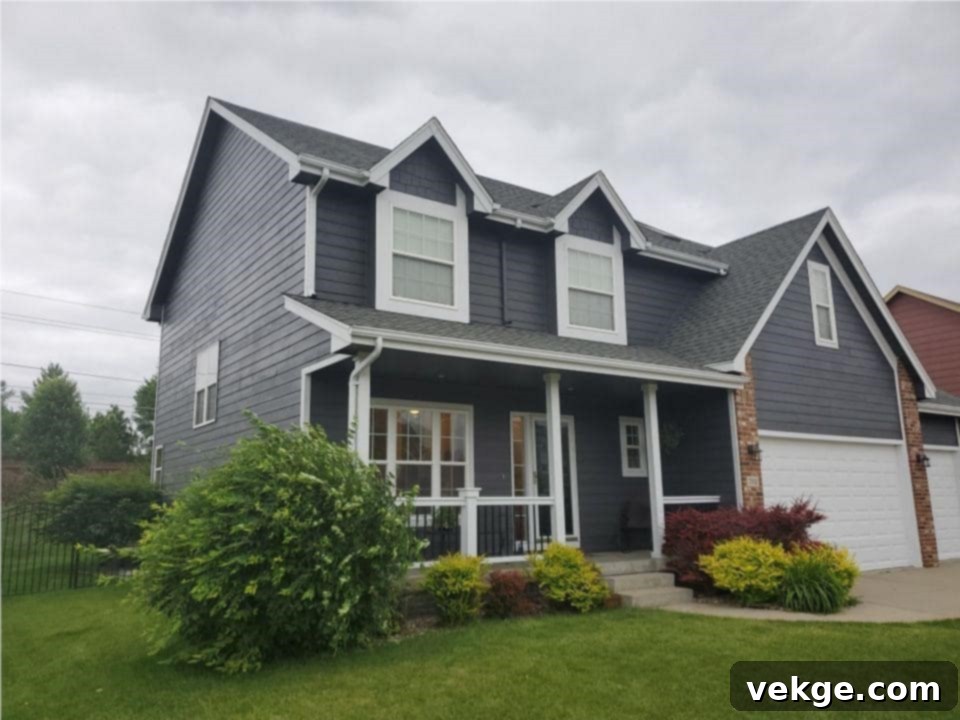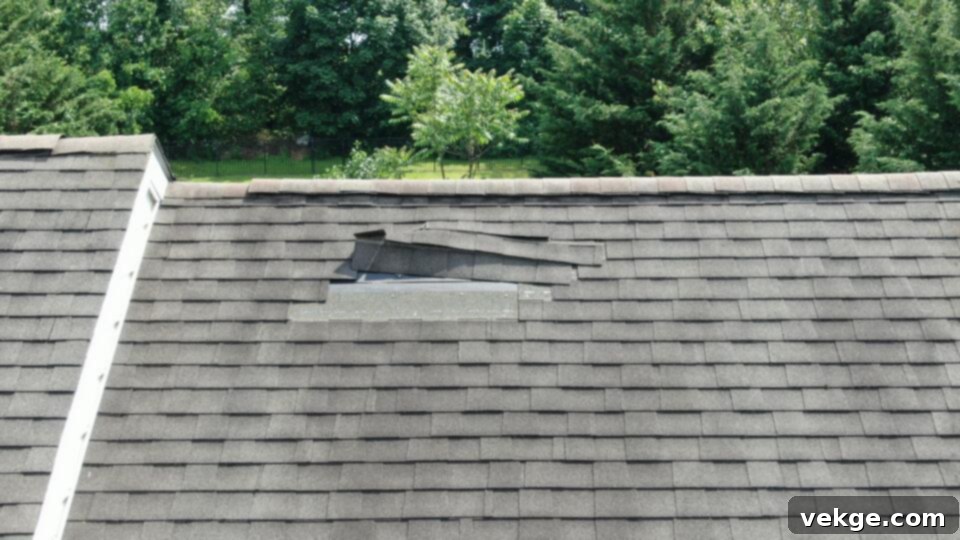Why a Professional Roof Inspection After a Storm is Crucial for Your Home’s Long-Term Protection
When a severe storm finally passes, leaving clear skies and calmer winds, it’s natural to feel a profound sense of relief. Many homeowners quickly scan their property, and if nothing immediately appears amiss, they often assume their home has weathered the storm unscathed. However, this initial assessment can be dangerously misleading. Beneath the surface, or in hard-to-see areas, hidden roof damage could be silently lurking. Left unaddressed, these seemingly minor issues can escalate into significant structural problems, costly leaks, and extensive repairs down the line. This is precisely why one of the smartest and most proactive steps you can take to safeguard your most valuable asset – your home – is to schedule a professional roof inspection immediately after any major storm event.
The Deceptive Nature of Hidden Storm Damage
Not all storm damage announces itself with missing shingles or visible holes. While these obvious signs are easy to spot from the ground, the more insidious types of damage often go unnoticed by the untrained eye. For instance, high winds can loosen the seals on shingles, lift flashing around chimneys or vents, or even cause invisible micro-fractures in the shingles themselves. Hail, even small hailstones, can create “bruises” or granular loss on asphalt shingles, significantly reducing their lifespan and protective capabilities without ever puncturing the material.
Over time, these seemingly minor issues become entry points for water. What starts as a small lifted shingle can lead to water seeping into the underlayment, rotting the roof decking, damaging insulation, and eventually manifesting as unsightly water stains on your ceilings or even mold growth within your walls. Professional roofers possess the specialized knowledge and equipment to identify these subtle indicators of damage. They know exactly what to look for, from granular loss on shingles and compromised flashing to potential issues in your attic that signal water intrusion. An expert inspection is the critical difference between catching a small problem that requires a straightforward repair today and facing a full, expensive roof replacement in the near future.
Navigating Insurance Claims with Professional Documentation
If your roof has suffered storm damage, your homeowner’s insurance policy is designed to help cover the costs of repairs or replacement. However, insurance companies typically require that claims be filed within a specific timeframe after the event. This window can vary, making a prompt inspection even more crucial.
Engaging a certified and reputable roofer to inspect your roof right after a storm serves several vital purposes. Beyond merely identifying damage, a professional inspection provides the essential documentation you’ll need if you decide to file an insurance claim. Most experienced roofing companies will furnish a comprehensive, detailed inspection report, often accompanied by high-resolution photographs and even drone footage. This report meticulously outlines the extent and nature of the damage, directly linking it to the recent storm. This unbiased, professional evidence significantly strengthens your claim, making the process smoother and increasing the likelihood of a fair settlement. Without this timely and thorough documentation, navigating the insurance claims process can become a bureaucratic nightmare, potentially leading to delays or even denial of your claim.
Proactive Repairs: Saving You Money and Headaches
The financial argument for immediate post-storm inspections is compelling. A tiny puncture from a falling twig or a shingle lifted by strong winds might not cause an immediate, noticeable leak. Your roof might appear to hold strong for days, weeks, or even months. Yet, during this time, water can slowly but steadily seep beneath the roofing materials. This insidious intrusion can lead to a cascade of costly problems:
- Rotting Decking: The plywood or OSB beneath your shingles can absorb moisture, leading to rot and structural weakening. This often necessitates extensive and expensive re-decking.
- Insulation Damage: Wet insulation loses its effectiveness, leading to higher energy bills and the need for costly replacement.
- Interior Water Damage: Visible water stains on ceilings and walls are often the first sign homeowners see, but by then, the damage is already significant and requires interior repairs and repainting.
- Mold and Mildew Growth: Dark, damp environments are perfect breeding grounds for mold, which can pose serious health risks and be incredibly expensive to remediate.
- Compromised Structural Integrity: Long-term water damage can weaken your home’s framing and supports, jeopardizing its overall structural soundness.
Addressing minor issues quickly after a storm is almost always far less expensive and less disruptive than dealing with major structural repairs, extensive mold remediation, or a full roof replacement later. A professional storm inspection provides you with a clear roadmap of necessary maintenance and helps you prioritize any needed repairs, preventing them from escalating into catastrophic expenses.
Understanding Common Types of Storm Damage
Storms manifest in various forms, and each can inflict unique damage on your roof. Recognizing these types of damage can help homeowners understand the importance of a professional assessment:
- Wind Damage: High winds are a major culprit, often lifting, tearing, or creasing shingles. Even if shingles aren’t completely blown off, their seals can be compromised, making them vulnerable to future leaks. Wind can also damage flashing, gutters, and other roof accessories, leading to systemic failure.
- Hail Damage: Hail, even small pellets, can cause significant impact damage. On asphalt shingles, this often appears as circular indentations, soft spots, or granular loss. While not always immediately obvious, hail damage weakens the shingle’s protective layers, accelerating its deterioration and making it prone to water penetration. Larger hailstones can even crack tiles, dent metal roofs, or damage skylights.
- Falling Debris Damage: Strong winds can turn branches, lawn furniture, or even entire trees into destructive projectiles. These impacts can cause punctures, cracks, or structural damage to your roof’s decking and underlying supports, requiring immediate attention.
- Heavy Rain and Water Intrusion: While rain itself doesn’t damage a healthy roof, coupled with other storm damage, it becomes a major threat. Compromised shingles or flashing allow water to bypass the roof’s defenses, leading to the internal issues described above. Clogged gutters from storm debris can also cause water to overflow and pool around your home’s foundation or seep into eaves.
A professional inspector is trained to identify all these specific types of damage, understanding how each affects the integrity and longevity of your roofing system.
What a Professional Roof Inspection Entails
A thorough post-storm roof inspection goes far beyond a quick glance from the ground. Experienced roofing professionals conduct a meticulous, multi-point assessment designed to uncover both obvious and hidden damage:
- Exterior Roof Surface: Examination of shingles for missing granules, cracks, tears, punctures, blistering, and proper sealing. This includes checking for wind-lifted or loose shingles.
- Flashing Inspection: Close examination of flashing around chimneys, skylights, vents, and valleys to ensure it’s securely in place and watertight. These are common areas for leaks to originate.
- Gutter System: Checking gutters and downspouts for blockages, proper alignment, secure attachment, and any signs of damage from debris or heavy water flow.
- Soffits and Fascia: Inspecting these components for water stains, rot, or physical damage, which can indicate issues with drainage or ventilation.
- Chimney and Vent Systems: Assessing the condition of mortar, caps, and covers on chimneys, as well as checking all roof vents for integrity and proper functioning.
- Attic Inspection: Crucially, inspectors will often go into your attic to look for signs of water penetration, mold, or mildew on the underside of the roof deck, insulation, and rafters. This provides direct evidence of leaks that may not yet be visible inside your living space.
- Structural Components: Looking for any signs of sagging, warping, or other structural issues that could indicate severe damage or long-term problems.
Many modern roofing companies also leverage technology like drones to get a safer and more detailed view of hard-to-reach or steep roof sections, ensuring no stone (or shingle) is left unturned.
Choosing a Trusted Partner for Your Roof’s Health

The choice of roofing company for your post-storm inspection and subsequent repairs is paramount. You need a partner you can trust to provide an honest, accurate assessment and deliver high-quality, reliable service. When selecting a roofing contractor, consider their local reputation, licensing and insurance, certifications, experience specifically with storm damage, and their track record with insurance claims. Look for companies that offer transparent communication, detailed estimates, and strong customer testimonials.
For homeowners in the Oklahoma area, Capstone Roofing is an excellent example of a company that has earned a strong reputation for providing thorough storm damage inspections and dependable repairs. Their team understands the nuances of assessing even the most subtle signs of storm-related damage and are adept at guiding homeowners through every subsequent step—whether it involves a straightforward repair or assisting with the complexities of navigating the insurance process to ensure you receive the coverage you deserve.
The Unquantifiable Value: Peace of Mind
After enduring a storm, you already have enough to manage without the added stress of worrying about the integrity of your home. A professional roof inspection provides invaluable clarity and a profound sense of peace of mind. Knowing that any potential issues have been identified and will be addressed quickly allows you to rest easy, confident that your home remains a safe and protected sanctuary. Whether it was subjected to the force of high winds, the impact of hail, relentless heavy rain, or falling debris, a storm undeniably puts your roof to the test. Getting it checked promptly is the single most effective way to ensure your home stays dry, secure, and structurally sound for many years to come, preserving both its value and your family’s safety.
Integrating Storm Inspections into Regular Roof Maintenance
While storm-related checks are reactive to specific events, they should ideally be integrated into a broader, proactive roof maintenance plan. Even if a particular storm doesn’t cause immediately visible damage, regular, scheduled roof inspections can catch aging materials, worn-out flashing, minor ventilation issues, or even debris accumulation that can lead to problems. Being proactive with general roof maintenance extends the overall lifespan of your roof, optimizes its performance, and keeps repair costs manageable over the long term. Combining annual maintenance checks with immediate post-storm inspections creates a comprehensive strategy for maximum roof longevity and home protection.
Don’t Delay: Act Now to Protect Your Investment
The message is clear: if your home has recently experienced a major storm, do not wait for the unmistakable signs of water stains on your ceilings, a noticeable drip, or a sagging roofline to appear before taking action. These are often indicators that significant, and expensive, damage has already occurred. Instead, schedule a professional roof inspection as soon as possible. By being proactive, you empower yourself to identify any hidden damage early and address it before it has the chance to worsen and compromise your home’s structure and interior. With experienced roofers by your side, you can ensure your home remains protected, resilient, and secure, no matter what unpredictable weather Mother Nature brings.
Investing in a timely professional roof inspection is not just a repair; it’s an investment in your home’s health, your financial stability, and your peace of mind.
